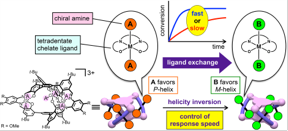Kanazawa University research: Chirality inversion in a helical molecule at controlled speeds
A strategy to invert the chirality of a metal-containing helical molecule controlling the speed of the response is reported in Chemistry
Chiral molecules cannot be superimposed on their mirror images – like hands. The two mirror images of a molecule, one right-handed, the other left-handed, are called enantiomers. Most molecules used in drugs are chiral, and only one enantiomer is effective (the other one can even be toxic), thus being able to control and manipulate the chirality of molecules is of foremost importance for a wide range of applications.

Scheme 1 from the paper
Some molecules can undergo a chirality change in response to external stimuli. In particular, dynamic helical molecules, which are in a dynamic equilibrium between the right- and left-handed forms, have been shown to switch chirality upon exposure to light, heat, redox reactions, changes in pH or binding with other molecules, for example by inserting organic molecules at the metal center of the helical complex. However, this last option is difficult to implement and very few successful instances have been reported so far.
Shigehisa Akine from Kanazawa University, in Japan, and colleagues now present a helical complex (a helical cobalt(III) metallocryptand) in which helicity changes can be triggered by introducing a variety of organic molecules in the helical structure. By replacing one ligand with a suitable other ligand, the helicity can be inverted, and the speed of the change can be controlled through the reactivity of the ligands, which is much simpler to do in practice than what is proposed in other protocols.
The molecule presented by the authors has a well-defined triple-helical structure, and six amine ligands that are coordinated to three octahedral cobalt(III) centers. Cobalt(III) ions normally form inert complexes and do not undergo ligand exchanges, but the cobalt(III) ions in this helical structure was found to undergo ligand exchange among amines. The authors demonstrated the dependence of the response speed on the combination of chiral and achiral amines as the starting and entering ligands, respectively, as a consequence of the difference in the reactivity of the Co-containing moieties. Several combinations of amines were tested, and different chiral amines were demonstrated to stabilize opposite helicities.
“We believe that these results will open the way for the development of new functional materials in which the response speeds can be controlled and the desired function is time-programmable using a suitable chemical stimulus,” say the authors.
Source: Nanotechnology Now
- 312 reads
Human Rights
Ringing FOWPAL’s Peace Bell for the World:Nobel Peace Prize Laureates’ Visions and Actions

Protecting the World’s Cultural Diversity for a Sustainable Future

The Peace Bell Resonates at the 27th Eurasian Economic Summit

Declaration of World Day of the Power of Hope Endorsed by People in 158 Nations

Puppet Show I International Friendship Day 2020

